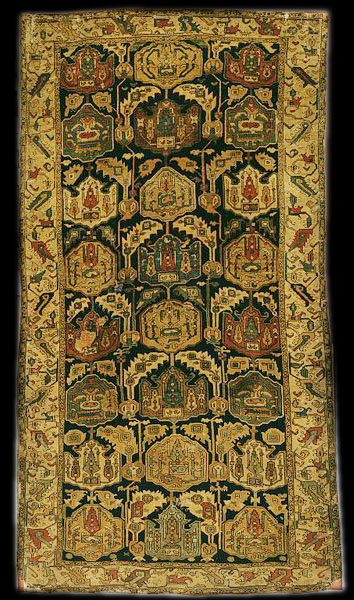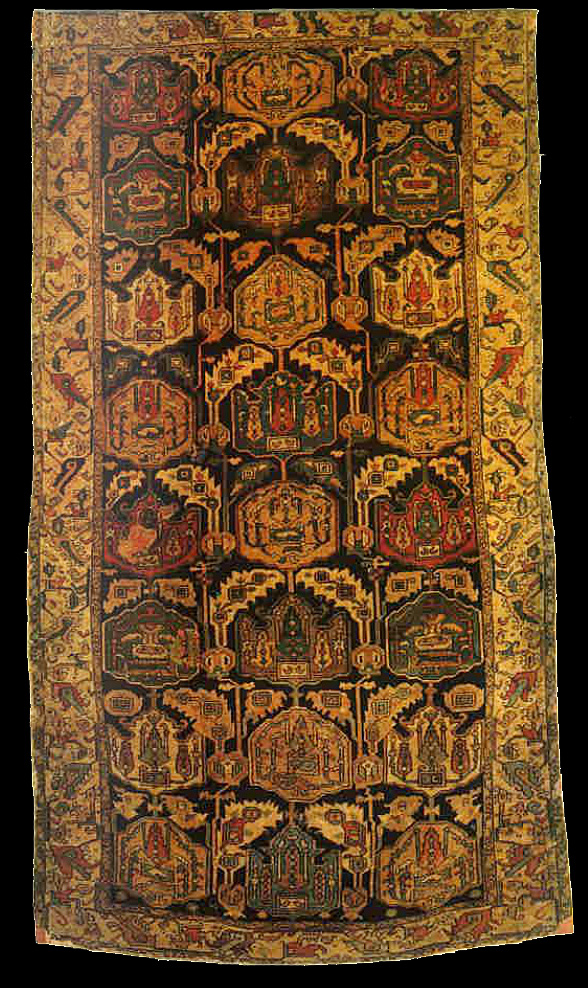|
Public access description
There are two very similar motifs in this carpet, at first glance they may
look identical. On the lower row the outer two form a pair and their
position alternates in subsequent rows. Their proportions vary slightly and
the weavers had to adjust the ones in the upper row because they
were running out of warp.
Physical description
Carpet, hand knotted woollen pile on woollen warp and weft, Caucasian,
19th century
WARP: white wool; Z2S; 20 threads to the inch (80 per dm).
WEFT: red wool and white wool; Z2S; 2 shoots after each row of knots,often
one red and one white especially in the upper 14" (35.5 cms) then
predominantly red only; 15 knots to the inch (60 per dm).
PILE: wool: 11 colours: red, dark yellow, dark green, green, dark blue,
blue, light blue, dark brown, brown, light brown, black, white;
symmetrical knot tied around 2 warp threads; 150 knots per sq.inch (2400 per
sq.dm)
SIDE FINISH: incomplete but 3 cords overcast with cream silk.
END FINISH: Lower: cut but evidence of plainweave with red wool. Upper: cut.
DESIGN: Field: a dark blue ground with three rows of 'shield' motifs across
the width in alteranting outlines of a geometric palmette and an indeted
octagon. The palmete shield encloses a tree with flower buds flanked by a
smaller pair and standing on a rectangle containing a pair of birds or fish.
The octagonal shileds contain in alternating bands a similar design with a
similar tree or a central rectangle from which spring a stylised flowering
shrub. A stem on either side of the central row rises to the top of the
carpet. From it large white serrated leaves with a floral filling frame the
palmette shields and smaller yellow or green leaves are above the octagonal
shields. These smaller leaves have a square or rectangular shape which gives
them the appearance of a bird's head.
Main border: white ground with a stylised meander with markedly diagonal
hooked blossoms.
Inner border: brown ground with black meander with a green S-motif and black
and white blossoms.
Outer border: as inner but with blue instead of white blossoms.
Catalogue Date: 17.11.97
Museum number
T.13-1944
URL: http://collections.vam.ac.uk/item/O67269/carpet/
Place of Origin: Azerbaijan (made)
Date: 1800-1899 (made)
Artist/maker: Unknown (production)
Materials and Techniques: Hand knotted woollen pile, on woollen warp and
weft; symmetrical knot tied; 150 knots per sq. in (2,400 per sq. dm)
Dimensions: Length: 235 cm maximum, Length: 228 cm minimum, Width: 134 cm
maximum, Width: 121 cm minimum
Production Note
Mentioned and illustrated in "Caucasian Rugs in the V & A", by M. Franses
and R. Pinner (intro. by Donald King). Hali 1980, Vol. 3, No. 2, p. 96, 98,
99, 112, 114
c.f. Yetkin (1978) Vol. II, illus. 198 (also in Erdmann (1976) illus. 116)
"Caucasian Floral Carpet".
Ellis (1975), illus. 33 and 34., "Shirvan, Shemakha ? 19th century"
Erdmann (1976) illus. 115, "Caucasus/N.W. Persia, 18th century".
Yetkin (1978) Vol. 1., illus. 37, "Floral carpet (Caucasian) transitional
type, late 18th century". and illus. 75 for main border.
Materials: Wool yarn
Techniques: Weaving; Knotting
Subjects depicted: Leaves; Stylized flowers; Medallions
|
 |


